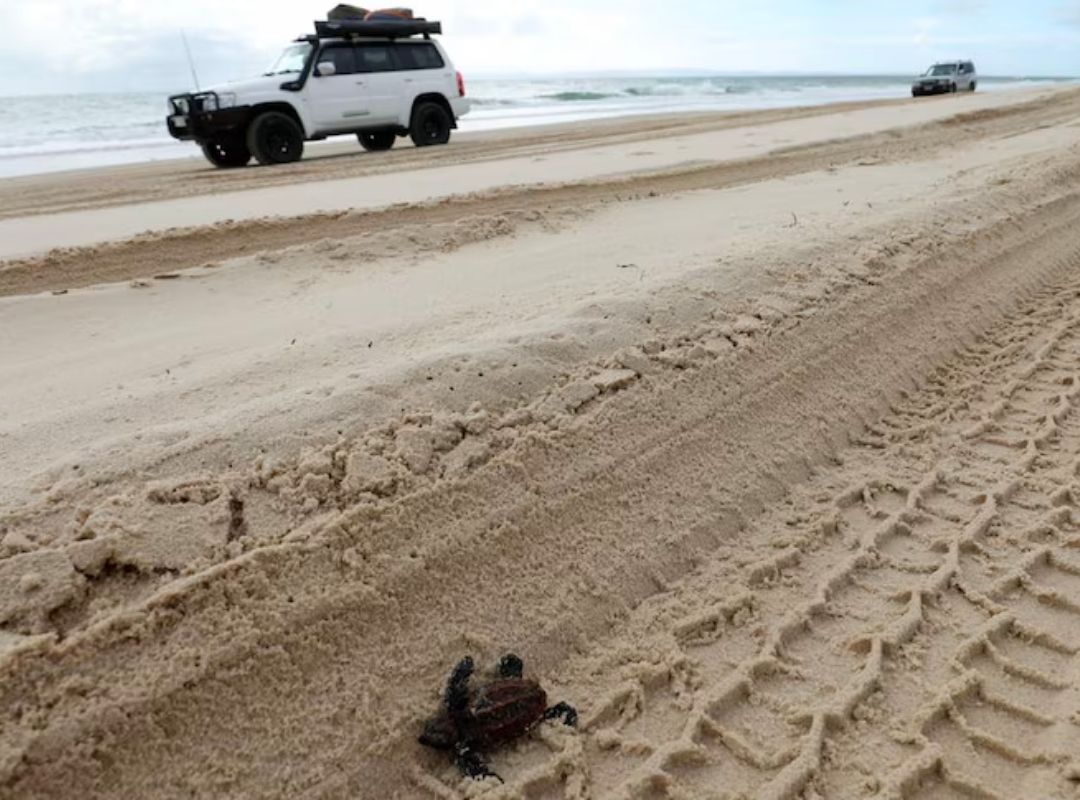Turtle Threats
Unfortunately humans have had a significant impact on turtles over time.
Even though turtles are now protected they still face considerable threats from human actions. The Recovery Plan for Marine Turtles in Australia evaluated 20 threats to populations of Australia’s marine turtles.
Some of the top threats as stated here are climate change, light pollution, bycatch, pollution and habitat destruction.
Even though turtles are now protected they still face considerable threats from human actions.
Climate Change
Warming sea temperatures caused by climate change are driving sea turtles to migrate further south in search of suitable nesting sites, while also increasing the frequency of natural disasters such as storms. These events, combined with rising sea levels, threaten to flood or erode traditional nesting beaches.
Additionally, higher sand temperatures can lead to nest mortality and skew the sex ratio of hatchlings, as warmer sand produces more females. This imbalance could affect long-term reproductive success and population stability, putting sea turtles at greater risk.

Light Pollution
Artificial lighting presents a significant threat to sea turtles, particularly during their nesting and hatching stages. Nesting females are often discouraged from coming ashore to lay their eggs in areas affected by artificial light, disrupting their natural reproductive behaviour.
For hatchlings, artificial lighting on beaches creates severe disorientation. Typically, hatchlings rely on natural light cues from the moon and stars to guide them toward the ocean. However, artificial light sources can interfere with this process, leading hatchlings away from the water and into hazardous environments. This disorientation greatly increases mortality, as hatchlings face higher risks of dehydration and predation. In regions with high levels of light pollution, these effects can contribute to substantial declines in sea turtle populations.

Bycatch
Bycatch, the unintentional capture of non-target species in fishing gear, poses a major threat to sea turtles. Turtles are often caught in nets, longlines, and trawls, leading to injury, drowning, or death as they become trapped and unable to surface for air. Even when released, many turtles suffer from long-term harm due to stress or physical trauma.
Bycatch significantly impacts turtle populations worldwide, contributing to the decline of several species, particularly those already endangered. Sustainable fishing practices and bycatch reduction technologies are essential to mitigating these effects and conserving sea turtle populations.

Pollution
Every day, thousands of tons of rubbish are dumped into the oceans globally, putting marine life under severe threat. Sea turtles, whose diets mainly consist of jellyfish, often mistake floating plastic debris for their prey. Ingesting this plastic can cause serious health issues, including intestinal blockages, bloating, malnutrition, and ultimately death.
Additionally microplastics, tiny plastic particles broken down from larger debris, pose a significant health risk to marine species through accidental ingestion. These microplastics can accumulate in the digestive systems of sea turtles and other marine organisms, causing internal damage and further threatening their survival. The widespread presence of plastic pollution in the oceans exacerbates the challenges faced by already vulnerable marine species.

Habitat Destruction
Human activities have a significant impact on turtle nests and hatchlings, particularly in highly developed coastal areas like the Gold Coast. Coastal development increases the presence of threats such as high foot traffic and beach users, both of which can disrupt turtle nesting and hatching processes.
Hatchlings face numerous challenges when navigating their way to the ocean. High foot traffic leaves behind footprints and sand disturbances that can act as obstacles, turning their journey into a struggle. Moreover, some beach users may unintentionally harm hatchlings by picking them up or further disturbing the sand.

The longer hatchlings remain on the beach, the lower their chances of survival. Extended exposure increases their risk of dehydration, exhaustion, predation, and other anthropogenic threats. Prolonged time on the beach also allows the sand to dry out and become less stable, making it harder for the hatchlings to reach the ocean as the tide recedes, further lengthening their journey.
Human objects, such as umbrellas, beach toys, and even sandcastles, can obstruct hatchlings as they make their way to the water. Umbrellas, if inserted into the dunes, can penetrate turtle nests and harm or kill the eggs. Beach toys and sandcastles also create additional obstacles for hatchlings. It’s essential for beachgoers to avoid placing these items in sensitive nesting areas, particularly around the dunes.

Vehicles, including beach cleaning tractors and 4WDs, pose an even greater risk. These vehicles can crush nests, compact the sand, and create deep tyre tracks that act as traps for hatchlings. Trapped in these tracks, hatchlings become easy prey for predators and are more susceptible to dehydration and overheating. It is crucial for drivers to stay on designated tracks and avoid driving on the dunes to minimise the impact on turtle nests and hatchlings.

Status
Despite global efforts to protect and conserve sea turtles, turtle populations have declined significantly, and of the seven species found in the world, three are classified by the United Nations as Endangered, and three as Critically Endangered.
In Australia sea turtles are protected under the Commonwealth Environmental Protection and Biodiversity Conservation Act 1999 (EPBC Act). Most of the significant nesting areas (‘rookeries’) for all species of turtles in eastern Queensland have been declared protected habitat under this Act and include key sites such as Mon Repos Conservation Park, Woongarra Marine Park and the Moreton Bay Marine Park.
Here on the Gold Coast, we have a number of sea turtle species visiting that are listed as nationally vulnerable, endangered or critically endangered in Australia. ‘Vulnerable’ means that the species may become endangered if threats to survival continue where as ‘Endangered’, indicates that the species may become extinct if the threats to survival continue.
